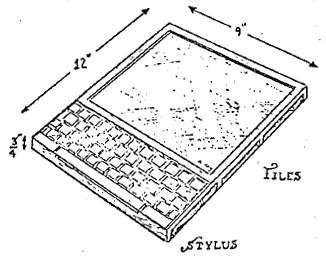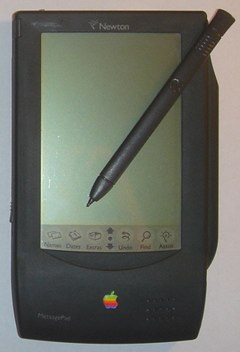The Classic Computing Blog


The Third Tier of Personal Computing
or “Whatever Happened to Pen Computing?!”
I wrote the following article for the second issue of 300 Baud magazine. I have taken the opportunity to update and edit it slightly.
Have you heard about Apple’s new iPad? C’mon, you must have by now. It’s new, new, new, and it’s going to change the world! I’m being a little sarcastic, but it will change the way many use a computer, at least in some specific tasks. The iPad will be the first serious contender in a mode of computing that has been struggling to mature for almost thirty years. It will cause a paradigm shift that is already taking place in the smartphone market (more on that later). The iPad is commonly known as a “tablet” computer, but it belongs in the category that has arguably existed since shortly after the personal computer became mainstream – the handheld. The handheld is the third tier of personal computing, and falls in between the two other tiers – the desktop and the laptop. The handheld can break down further, with many different sizes, styles and interfaces. The most common ones are the palmtop (with QWERTY keyboard), PDA (personal digital assistant) and the tablet.
Ever since the laptop really started to take off in the mid-1980s, its life has seemed ultimately doomed, to be replaced by just a screen. A screen that could do everything a regular laptop could do, and more. In the late 1980s, there arose a small buzz in the portable computer industry, and it steadily grew louder. The buzz was about the so-called “pen computers.” These systems generated a lot of excitement at the time, and it seemed inevitable that they would eventually replace conventional laptop computers, perhaps even traditional desktops. After all, those all used keyboards. It just seemed to make sense that a singular input / output device would be the way to go – the screen. Also, using a “pen” seemed the natural choice for writing without a keyboard. As graphical user interfaces started to appear, the pen as a stylus, seemed just right for the interface too.

Dynabook, original illustration from Alan Kay’s 1972 paper
About twenty years earlier, before there were personal computers of any kind, Alan Kay created the concept for the “Dynabook” in 1968. This was two years before the founding of Xerox PARC, where he would go on to work. Many of his ideas led to the development of the Xerox Alto prototype, which was originally called “the interim Dynabook.” The Dynabook concept paved the way for what is now known as a notebook computer, and even the tablet computer in some of its other incarnations. As personal computers evolved, they became faster and their circuitry became smaller; this made the “luggable” computer possible, then the laptop. The central theme to Alan Kay's idea was however, that of a book-sized device, with the power of a super computer. The technology to realize his vision had yet to be developed, but others shared the design and usability goals.

Original Apple Newton, MessagePad 100
Keyboards originated in the 19th century with mechanical typewriters, so the pen seemed the logical evolution in how people would work on computers in the future. The pen was also seen early on by many as critical to the handheld concept, especially when coupled with handwriting recognition. It was this mindset that became the “albatross” to the pen computing paradigm. In the early 1980s, handwriting recognition was predicted as the most important future technology in computing. Unfortunately, the technical reality was unable to live up to expectations, at least initially. The most notable example of this was embarrassingly demonstrated with the arrival of Apple’s Newton. Or at least, that was the perception. The handwriting system on the original MessagePad was designed to recognize entire words rather than single letters, as Palm eventually developed with their Graffiti system in 1994. Apple’s engineers chose this method because focus group data had indicated that people wanted to write in cursive. When the system made a mistake, it would often pick a word that was different than the one intended, which lead to much ridicule. This ridicule and criticism was summed up regularly in the newspaper comic strip Doonesbury by Gary Trudeau and was even lampooned in The Simpsons. Apple corrected these problems with the Newton OS 2.0 (almost three years later), but the damage had been done. Ironically, even more than a decade later, Newton's handwriting recognition has been praised as some of the best in the industry.

Pen computing hype reached its peak between 1992 and 1994, as a number of companies introduced software and hardware. GO released its PenPoint OS, which was truly pen-centric, but had a steep learning curve, Microsoft released Windows for Pen Computing, running on top of Windows 3.1 and Lexicus Longhand handwriting recognition software was released. Momenta created its own hardware and a pen interface running on top of DOS. Other notable hardware manufacturers were AT&T, Compaq, Dauphin, Fujitsu, IBM, NCR, TelePad, Toshiba and Samsung.

Some of these were laptops, and others were more palmtop and tablet-like. But it was really Apple’s Newton and the PDA concept that brought pen computing and the awareness of touch interfaces into the public consciousness. The hype surrounding the Newton was incredible, as Apple had some pretty good commercials even back in 1993 (there’s an interesting similarity between a Newton commercial and an iPad commercial, link below). The Newton was quickly emulated by the likes of Amstrad, AT&T, Casio / Tandy and a few others. The hoopla surrounding the Newton had set high expectations, but the device did not live up to it. The “clones” did an even poorer job in meeting the expectations of this computing future.

The PDA market collapsed as fast as it had false-started. Pen based computer companies began failing, with many non-PDA and tablet manufacturers included. Momenta shut down after only ten months on the market. AST purchased pen pioneer GRiD for its manufacturing capacity, then stopped all pen projects. Dauphin went bankrupt owing IBM over $40 million. GO was taken over by AT&T, and AT&T closed the company in August 1994 (this was after the interesting “You will . . .” - faxing on the beach, etc. TV commercials). Compaq, IBM, NEC and Toshiba had all stopped making consumer pen products by 1994. By this time, the very term "pen computing" seemed like a joke. The market mocked and abandoned the whole concept, especially that of handwriting recognition. Pen computing as a new interface to computers was seen as a failed technology. For years after, the pen as a stylus, was mostly used in the more lowly organizer category by Sharp and a few others. It wasn't until late 1997, when the PalmPilot became popular and its sales began to grow, that slowly a renewed interest and confidence in this input method grew, but in a more specific and humbled way. An organizer was a far cry from a full-featured pocket computer.

Sharp Wizard OZ-9600II, 1994
During the last decade, the idea of a “pen computer” has mostly disappeared, and replaced with the concept of the hybrid tablet / laptop (or “Tablet PC”), where the screen turns around to lie flat and thus allow the computer to be used as a tablet. During this time, tablet concepts have been almost completely dominated with pen-based Windows operating systems. In 2000, Microsoft showed off a prototype and said that the first Tablet PCs would come to market in 2002. In 2001, Microsoft announced the Tablet PC standard, which was defined to be a pen-enabled computer conforming to hardware specifications devised by them and running a licensed copy of Windows XP Tablet PC Edition. At Comdex in the same year, Microsoft chief software architect Bill Gates said in his keynote: "The Tablet is a PC that is virtually without limits, and within five years I predict it will be the most popular form of PC sold in America." Microsoft has predicted the rise and domination of the tablet computer on numerous occasions since, yet it has not materialized.

Handspring Treo 180, 2002
So what’s the future for pen computing? Well, it’s thriving, or it’s dead, it really depends on how you look at it. The original concept of pen computing was way ahead of its time. With the PDA, the real irony was that it devolved into the organizer, a far more limited computer, but far more successful. The Palm device reached a refinement after the year 2000, and as it gained more computer-like features, it was turned into a phone! One of the first smartphones in the US was the Handspring Treo 180 in 2002. This development gave birth to the current push towards true handheld computing, and in a way “pen computing.” Pen computing exists now, and has a very promising future, just without . . . well, without pens! Yes, there are still those Windows-based hybrids, and there are even some tablets and rugged PDA-like devices that use pens, but those aren’t in the mainstream, or the future. In 2007, Apple introduced a new smartphone, and it was so incredibly ahead of everything else, that it changed the standard in a big way. All smartphones are now judged against the iPhone. The iPhone gave way to the iPod Touch, and that has now given us the iPod Touch XL – the iPad! The finger is the new pen, and all of these devices have virtual keyboards, so the keyboard is not dead, yet. The iPhone has serious competition now in Android phones, and we are seeing the first Android based tablets. So, this is what “pen computing” is now – multi-touch based, web enabled, communication tablets (of different sizes). Not to sound like too much of an apple fanboy, but it appears that Apple truly drives the standard on all FOUR of our current computing platforms – desktop, laptop, smartphone and tablet.

There was an interesting video in the tech news earlier this year, in which Microsoft demonstrates a unique computer book concept. It brings four components together – the pen / stylus, Windows (or at least a Microsoft OS), multi-touch and handwriting recognition. The device was called the Microsoft Courier and it was to include two screens that faced each other, in a book form factor. The user would be able to input, drag, copy, etc. across the “pages.” In April, Microsoft announced that it was no longer working on this project, yet in June they received a patent for a “dual display device.” It’s an impressive video, take a look at the link below.
Newton & iPad ads, coincidence?!: http://www.youtube.com/watch?v=iPnnhcKW2cU
AT&T "You Will" ad: http://www.youtube.com/watch?v=2kfIFDX9kE4&feature=related
Microsoft Courier: http://www.youtube.com/watch?v=pFQWc79TYcU
Dynabook & iPad, coincidence?!: http://www.tomshardware.com/news/alan-kay-steve-jobs-ipad-iphone,10209.html
Friday, January 13, 2012


